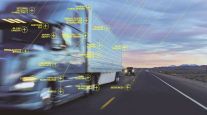Perspective: Trucking’s Telematics Systems Are Only as Good as the Losses They Prevent
[Stay on top of transportation news: Get TTNews in your inbox.]
Rising insurance premiums are a perennial stress for many motor carriers, many of which are now installing telematics systems with the latest safety technologies to mitigate cost increases. This is a positive trend for the trucking industry, and more carriers should fully embrace these technologies as they soon will become necessary to operate a safe, efficient and, ultimately, more profitable trucking fleet.
Motor carriers that install telematics systems in their trucks often assume it will immediately reduce their insurance premiums. Telematics systems, which use onboard hardware to capture and transmit information to a carrier’s back-office operations, can provide data as granular as individual driver seat belt use and hard braking; or, the data can be as expansive as average fleet speed. If properly used, these systems can reduce a carrier’s overall costs related to safety incidents. However, insurance premiums are likely to only be marginally impacted.
In an age of “nuclear verdicts” against motor carriers — which range from $10 million to $247 million — insurance companies must closely monitor their bottom lines to make sure they are accurately pricing risk.

Wieroniey
Telematics data is a useful tool to more precisely calculate risk. However, the algorithmic method by which insurance companies determine an individual motor carrier’s insurance premium does not lend itself to much personalization based upon carrier-specific telematics data.
Insurers examine a motor carrier’s three- to five-year claims data when setting premiums, which means the carrier may get a small discount for adding safety technologies, such as inward-facing cameras or collision mitigation and avoidance systems. The real discount, though, will be realized in three to five years if those devices have had a measurable impact on the carrier’s claims data.
In brief, telematics systems are only as good as the losses they prevent.
Telematics still represents a sound long-term investment and can reduce certain short-term costs. However, given the significant costs to install and maintain many of these technologies, the desired return on investment may take a little longer to achieve than anticipated.
WANT MORE NEWS? Listen to today's Daily Briefing
First, the short-term savings: The installation of telematics devices has an immediate impact on losses stemming from unsafe behaviors by drivers. Drivers are less likely to engage in risky behaviors once they are aware these behaviors are being monitored. According to one transportation insurance expert, the presence of a telematics device generally reduces loss costs by 20% to 25% through reduced deductibles.
Second, telematics provides hard data on favorable times and place of lanes traveled that could help reduce premiums. Insurers now are examining aggregate telematics data to determine which geographic regions, and even specific lanes, pose the greatest claims risk. Underwriters also have been able to parse out higher-risk travel times for specific locations.
RELATED: Fleets can reduce costs by deploying a number of technology devices
Motor carriers should make sure their premiums accurately reflect when and where they are operating their trucks. For example, if a carrier has data to show it runs most of its freight in a lower-risk lane during a lower-risk time of day, that carrier may be able to negotiate lower premiums.
The use of telematics on the maintenance side reduces short- and long-term costs. Being able to more closely monitor driver behavior, such as excessive hard-braking (often a result of a lead foot on the accelerator) can help reduce brake repairs and fuel consumption, and reduce the potential for rear-ending stopped or slowed vehicles.
Ultimately, insurance companies will be the driving force behind wide-scale adoption of telematics devices.
In the not-too-distant future, insurers likely will require the disclosure of telematics data — which would be a good thing for the industry. By using telematics data to more accurately price risk, insurers reward the safest fleets and ensure the riskiest fleets are paying their fair share. This provides an additional financial incentive for safety.
Looking further down the road, the long-term cost savings from telematics can be substantial. If this technology prevents crashes, it will have a major impact on premium rates once that’s borne out in a motor carrier’s three-year claims history.
Melton Truck Lines Inc. is one of many motor carriers that recently invested in upgrading various safety technologies in its trucks.
“All 1,300-plus of our trucks are equipped with forward- and rear-facing cameras,” Chief Financial Officer Robert Ragan said. “We have received a nice return on that investment in the form of litigation defense as well as driver counseling-coaching.”
Tulsa, Okla.-based Melton Truck Lines ranks No. 85 on the Transport Topics Top 100 list of the largest for-hire carriers in North America.
All Melton trucks also will be equipped with collision mitigation and avoidance technology by the end of the year, Ragan said.
“These are not small investments; however, we will save money in the long run with reduced premiums and accident costs,” he said. “In addition to the financial incentives, we also feel an obligation to society to purchase the technologies that save lives.”
Like Melton, many motor carriers feel an obligation to install these technologies, which work in conjunction with telematics systems, because they know that it will save lives. Tragically, in 2017 nearly 4,800 individuals perished in accidents involving a truck, according to data from the Federal Motor Carrier Safety Administration.
Going forward, it’s expected that advanced telematics systems can help reduce this number significantly. For example, FMCSA reports that 45% of the 841 truck drivers who died in crashes in 2017 were not wearing seat belts. These deaths are easily preventable with technology by allowing companies to better record driver behavior and further cultivate a company’s safety culture.
Given the litigious nature of the trucking business climate and increased frequency of nuclear verdicts, higher insurance premiums may be unavoidable. However, forward-looking fleets can mitigate these increases for the long term by outfitting their vehicles now with the latest telematics systems that incorporate safety technologies.
Jennifer Wieroniey is the director of the National Accounting & Finance Council for American Trucking Associations. The NAFC engages in advocacy, education and research of risk management, tax, accounting and finance matters affecting the trucking industry.





